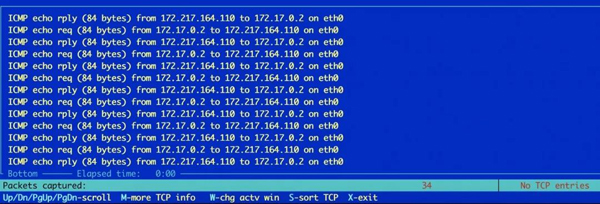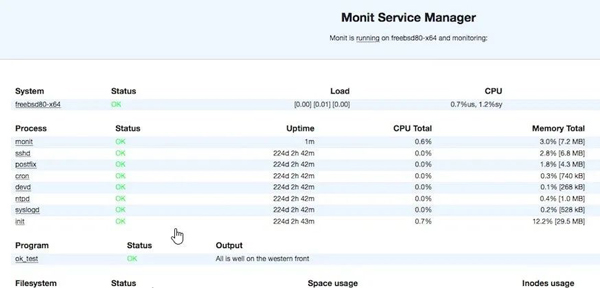A powerful tool for mastering Linux system monitoring
As a Linux system administrator, do you often need to monitor the performance of the system so that problems can be discovered and solved in a timely manner? If so, then you definitely need to know some Linux system monitoring tools. Today, we will introduce you to some commonly used Linux system monitoring tools so that you can easily master system monitoring skills.
1. iotop

If you want to know how much of your precious I/O resources are being used by certain processes, use iotop.
The iostat command also checks the I/O status, but it monitors the I/O situation at the system level, while iotop monitors the process level, and can monitor the I/O information used by which process.
2. htop

htop is an enhanced version of the traditional top, with better visual effects and easier to understand the current system status.
You can clearly see the usage of each core of the CPU, which is not as obscure as top.
Similarly, the memory usage is also very clear.
Not only does it have traditional percentage data, it also uses bar charts to display CPU and memory metrics. The readability is much better than top.
And the operation is more convenient. For example, you can terminate a process without entering the process ID, and you can also terminate multiple processes at one time.
htop also has many convenient operations, and it is recommended to use it instead of top.
3. IPTraf

IPTraf is a powerful tool for diagnosing network problems. It can monitor all network traffic of the system.
You can set filters for specified ports and transmission types.
IPTraf is like a lightweight Wireshark.
You can do many detailed operations through IPTraf, such as statistical breakdown of traffic based on overall packet size:

tcpdump or tshark have similar functions to IPTraf, but IPTraf is more convenient to use, has menus, and is easy to operate.
4. Monit

Monit is a very flexible tool with many configuration methods and supports different types of thresholds and performance alarms.
Monit allows monitoring of processes, ports, files and other targets, and can set dynamic alarm modes.
For example, you want to monitor a process to ensure that it is running. If the process hangs, restart it. If the process hangs multiple times, it will not restart, but will send an alarm. Such needs can be easily solved through Monit.
Monit also has a lightweight web interface:

Whether you are managing one server or multiple servers, Monit is a powerful monitoring tool that is extremely simple to use and very efficient.
As one of the commonly used operating systems, Linux system is highly praised by the majority of users for its stability and security. However, even the most stable systems have potential risks of failure. Therefore, in daily work, the importance of Linux system monitoring tools cannot be ignored. This article introduces some common Linux system monitoring tools, hoping to help Linux system administrators better discover and solve problems and ensure the stability and security of the system.
The above is the detailed content of A powerful tool for mastering Linux system monitoring. For more information, please follow other related articles on the PHP Chinese website!

Hot AI Tools

Undresser.AI Undress
AI-powered app for creating realistic nude photos

AI Clothes Remover
Online AI tool for removing clothes from photos.

Undress AI Tool
Undress images for free

Clothoff.io
AI clothes remover

Video Face Swap
Swap faces in any video effortlessly with our completely free AI face swap tool!

Hot Article

Hot Tools

Notepad++7.3.1
Easy-to-use and free code editor

SublimeText3 Chinese version
Chinese version, very easy to use

Zend Studio 13.0.1
Powerful PHP integrated development environment

Dreamweaver CS6
Visual web development tools

SublimeText3 Mac version
God-level code editing software (SublimeText3)

Hot Topics
 1389
1389
 52
52
 How to view the docker process
Apr 15, 2025 am 11:48 AM
How to view the docker process
Apr 15, 2025 am 11:48 AM
Docker process viewing method: 1. Docker CLI command: docker ps; 2. Systemd CLI command: systemctl status docker; 3. Docker Compose CLI command: docker-compose ps; 4. Process Explorer (Windows); 5. /proc directory (Linux).
 What computer configuration is required for vscode
Apr 15, 2025 pm 09:48 PM
What computer configuration is required for vscode
Apr 15, 2025 pm 09:48 PM
VS Code system requirements: Operating system: Windows 10 and above, macOS 10.12 and above, Linux distribution processor: minimum 1.6 GHz, recommended 2.0 GHz and above memory: minimum 512 MB, recommended 4 GB and above storage space: minimum 250 MB, recommended 1 GB and above other requirements: stable network connection, Xorg/Wayland (Linux)
 vscode cannot install extension
Apr 15, 2025 pm 07:18 PM
vscode cannot install extension
Apr 15, 2025 pm 07:18 PM
The reasons for the installation of VS Code extensions may be: network instability, insufficient permissions, system compatibility issues, VS Code version is too old, antivirus software or firewall interference. By checking network connections, permissions, log files, updating VS Code, disabling security software, and restarting VS Code or computers, you can gradually troubleshoot and resolve issues.
 Can vscode be used for mac
Apr 15, 2025 pm 07:36 PM
Can vscode be used for mac
Apr 15, 2025 pm 07:36 PM
VS Code is available on Mac. It has powerful extensions, Git integration, terminal and debugger, and also offers a wealth of setup options. However, for particularly large projects or highly professional development, VS Code may have performance or functional limitations.
 What is vscode What is vscode for?
Apr 15, 2025 pm 06:45 PM
What is vscode What is vscode for?
Apr 15, 2025 pm 06:45 PM
VS Code is the full name Visual Studio Code, which is a free and open source cross-platform code editor and development environment developed by Microsoft. It supports a wide range of programming languages and provides syntax highlighting, code automatic completion, code snippets and smart prompts to improve development efficiency. Through a rich extension ecosystem, users can add extensions to specific needs and languages, such as debuggers, code formatting tools, and Git integrations. VS Code also includes an intuitive debugger that helps quickly find and resolve bugs in your code.
 What is the main purpose of Linux?
Apr 16, 2025 am 12:19 AM
What is the main purpose of Linux?
Apr 16, 2025 am 12:19 AM
The main uses of Linux include: 1. Server operating system, 2. Embedded system, 3. Desktop operating system, 4. Development and testing environment. Linux excels in these areas, providing stability, security and efficient development tools.
 How to run java code in notepad
Apr 16, 2025 pm 07:39 PM
How to run java code in notepad
Apr 16, 2025 pm 07:39 PM
Although Notepad cannot run Java code directly, it can be achieved by using other tools: using the command line compiler (javac) to generate a bytecode file (filename.class). Use the Java interpreter (java) to interpret bytecode, execute the code, and output the result.
 How to use VSCode
Apr 15, 2025 pm 11:21 PM
How to use VSCode
Apr 15, 2025 pm 11:21 PM
Visual Studio Code (VSCode) is a cross-platform, open source and free code editor developed by Microsoft. It is known for its lightweight, scalability and support for a wide range of programming languages. To install VSCode, please visit the official website to download and run the installer. When using VSCode, you can create new projects, edit code, debug code, navigate projects, expand VSCode, and manage settings. VSCode is available for Windows, macOS, and Linux, supports multiple programming languages and provides various extensions through Marketplace. Its advantages include lightweight, scalability, extensive language support, rich features and version




